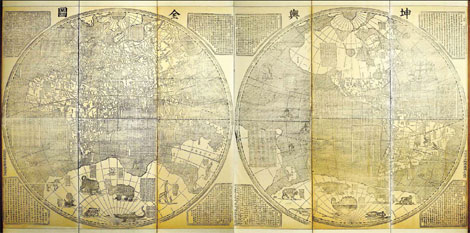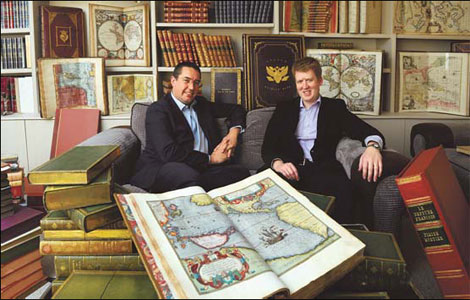Putting China on the map
Updated: 2011-11-29 15:28
By Liu Wei (China Daily)
|
|||||||||
 |
|
The world map developed by Jesuit father Ferdinand Verbiest during his mission to China in 1674. Photos provided to China Daily |
 |
|
London art dealer Daniel Crouch (left) and his partner Nick Trimming. |
Old maps of China are sought after by collectors due to the nation's increasing importance worldwide. Liu Wei reports.
Nine years ago, London-based art dealer Daniel Crouch could buy a 1584 map of China for 2,000 pounds ($3,098). It would cost him 5,000 pounds now. "I would be very surprised if it was less than 10,000 pounds in two years' time," he says.
Crouch has been a maps and atlases dealer for 18 years and has set up a new store with his friend Nick Trimming. He believes old maps are both hidden treasures and create a growing market.
The most eye-catching artifact in his catalogue is a copy of the world map developed by Jesuit father Ferdinand Verbiest, during his mission to China in 1674.
Verbiest, a mathematician, astronomer and cartographer in the Qing Dynasty (1644-1911) royal court, depicts the world as two hemispheres, a projection that had not been developed in Chinese mapping before.
Following a 1602 world map by Matteo Ricci, another renowned China missionary, Verbiest placed the Middle Kingdom at the center of the world, which Crouch believes was politically prudent.
"You can imagine, if you took a map to the emperor, showing China at the top right of it, you wouldn't have a lot of time left," he says.
"The world is a sphere, and you can put the center wherever you want. Actually, maps did not have north at the top as a convention until the middle of the 18th century."
David Park, map and manuscript specialist of renowned auctioneer Bonhams, agrees with Crouch's assessment.
"They did it deliberately and cleverly," he says. "When the Jesuits entered China, they realized, as far as the emperor was concerned, China was the center of the world."
"The idea of showing China on the edge of the world, as it was shown on European maps, would be rather foolish. It was not going to impress the emperor or the mandarin class at all. They decided to put China in the middle, as China is always in the middle of Chinese maps."
The Verbiest map updates the Ricci map by changing its oval projection to two circles, which shows the world more as a sphere, and adapts the placement of the poles. It was originally engraved on wood and printed with Chinese annotations by Chinese and Jesuits.
"It is a celebration of the meeting between East and West," Park says. "It was done by a Western cartographer but in an Eastern style, putting China at the center of the world."
The 1.8-by-3.4-meter map is the third copy Crouch has seen and he estimates the price to be about 30,000 pounds.
Prices of old maps of China have gone up in leaps and bumps in recent years, Park of Bonhams says.
"The idea that maps are works of art on paper was traditionally not highly regarded in China," he says. "But these are fascinating objects, and they are all incredibly rare now, at least those from the 16th and 17th centuries. The number of maps we have been able to offer in recent years at auctions in the UK and the US are very, very few."
Park adds that he is "absolutely confident" that if they found any distinctive Chinese maps of any period, they would sell well.
"It's finding them that is difficult," he says.
Park had a sale in 1998 of some early maps of China. They were exhibited in Hong Kong, but nobody there seemed interested at all, he says. But as Chinese collectors increasingly become a power in the international art market, the situation is changing.
"Besides traditional sought-after areas, such as jade and ceramics, they (Chinese collectors) are looking for other interesting things, which are relevant to their country. These rare maps fill the bill."
Crouch agrees and adds that Chinese maps also attract Western buyers.
"Maps of China are among the most desirable at the moment," he says. "There is a fair amount of interest in China from Western businesses. A lot of people are buying maps of China because it is related to the place they are interested in."
The most sought-after maps of China on the market are Ricci's maps, which Park says were revolutionary because, for the first time, Western science was incorporated into Chinese mapping.
"For conservative Chinese map makers, the oceans were unimportant. It was China that was important. The Ricci map overturned this idea," he says. "We put you at the center of the world, but you are just a small part of it."
Ricci maps are rare. Park claims that they are almost impossible to buy now. A few are in museums and libraries, but not many were left in China because from the early 18th to the 19th centuries, Chinese emperors changed their attitudes toward Catholicism and many missionaries were expelled from China.
A Ricci map is Crouch's dream. He sold one to the James Ford Bell Library in Minneapolis last year for $1 million.
"I wish I could find six more," he jokes.
Most of Crouch's buyers, he says, are "rich male seniors".
"In the map collecting world, old is over 90. I have several customers over 90. And the vast majority of my buyers are men. There are just five to six female buyers."
Maps are fascinating, Crouch and Park say, because they are beautifully drawn and capture history in a visual way.











